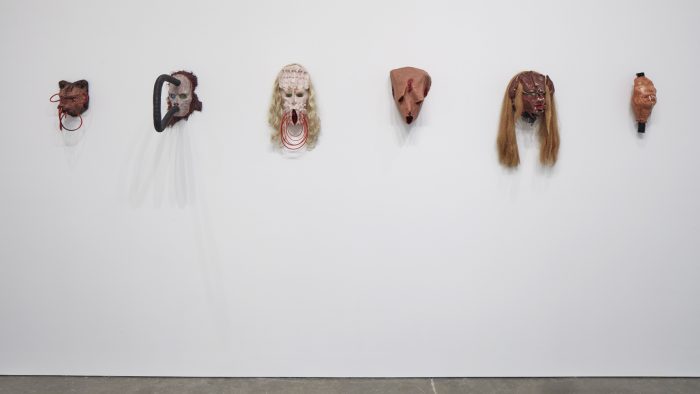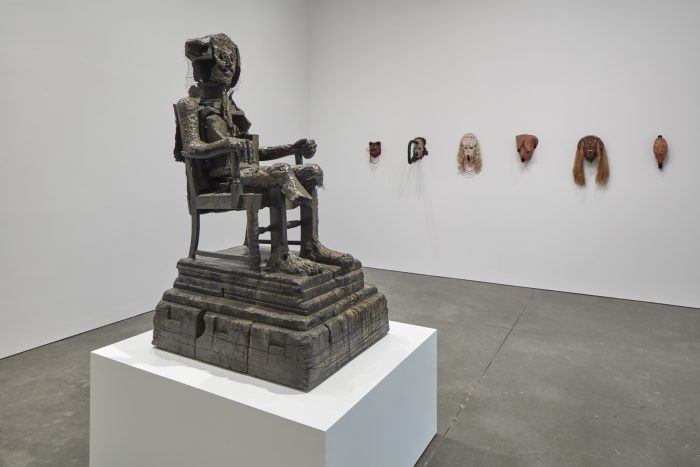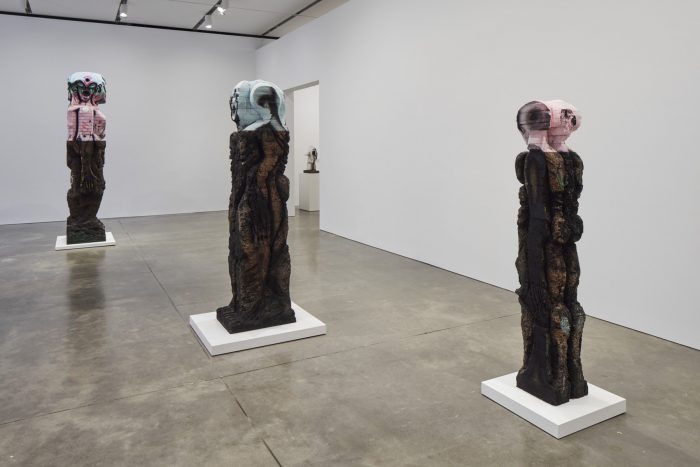Tiempo de lectura: 5 minutos

09.05.2019
Institute of Contemporary Art Boston, Boston, Massachusetts, USA
23 de marzo de 2019 – 27 de mayo de 2019



The Institute of Contemporary Art/Boston (ICA) presents Huma Bhabha: They Live, the largest survey of the artist’s work to date. Spanning over two decades of Bhabha’s work, this major exhibition features sculpture, drawing, and photography, and considers the artist’s engagement with the human figure. Best known for her sculptures, Bhabha uses a wide variety of materials ranging from clay, Styrofoam, bronze, bricks, wood, construction materials, and other found material, to make compelling works that engage the arts and histories of diverse cultures. Tending towards the grotesque, Bhabha’s sculptures feature hybrid bodies or figures that appear human, animal, or alien, and evoke life in a post-apocalyptic or ruined landscape. Her work transcends a singular time and place, instead creating an exploration of what the artist describes as the “eternal concerns” found across all cultures and temporalities: war, colonialism, displacement, and memories of home. On view March 23 through May 27, 2019, Huma Bhabha: They Live is organized by Eva Respini, Barbara Lee Chief Curator.
“Huma Bhabha’s quiet authority, persevering vision, and commanding work distinguish her as an exceptional artist with a unique and haunting artistic voice. This overdue exhibition offers visitors the opportunity to experience and understand the sweep and power of Huma Bhabha,” said Jill Medvedow, the ICA’s Ellen Matilda Poss Director. While Bhabha works primarily in sculpture, she also makes drawings, photographs, and prints. Her drawings in pastel and ink incorporate a skillful blend of figuration and abstraction. In many of these works, she has composed an image, whether a face or body part, and persistently traced and retraced the lines within the composition, which result in haunting, blurred effects. Bhabha’s reworked photographs, many taken by the artist in her native Karachi, are layered with her own markmaking, referencing the documentary photography tradition with a personal and fantastical dimension.
“The artist’s hand and a certain primacy of her interactions with materials are central to Bhabha’s practice. She deploys a distinctive mixture of additive and reductive methods to create her sculptures, with intuition driving her process, resulting in works that appear unfinished,” said Respini. “With their raw beauty, haunting presence, and narrative associations, Bhabha’s works adamantly broadcast the mutable, volatile, and expressive capacities of the figure.”
Huma Bhabha: They Live presents nearly 50 of the artist’s most significant artworks, including several of her newest works, such as the large scale bronze Benaam, recently featured on the rooftop of the Metropolitan Museum of Art in New York. The exhibition’s organization is not chronological, but rather influenced by the three foundational figural modes seen throughout the history of sculpture: standing, sitting, or reclining, in which Bhabha often positions her figures, or characters, as she calls them. The first room, for instance, exhibits a range of media and strategies Bhabha has employed over the years, from her early wall-mounted masks to sculptural figures composed of both found and traditional materials, introducing viewers to the breadth of her practice. Each of the subsequent galleries demonstrates how she engages the figure, nodding to art historical traditions—ancient Egyptian figures to Greek kouros—along with pop cultural sensibilities.
Exhibition Highlights
Bhabha’s work is a synthesis of her varied interests in art, history, film, television, and current events. Representing a refreshing and novel take on the figure, her hybridity: they are often intersex, multiethnic, and sometimes embody both animal and human characteristics. They are also hybrid in their making, composed of myriad combinations from organic to manufactured materials.
– The Orientalist (2007) is perhaps the most imposing and archetypal of Bhabha’s seated figures. Originally made from Styrofoam, wood, metal, wire, and clay, and then cast in bronze, the figure seems to have been wasting away at the moment it was cast, its mask like face both haunted and impassive. Bhabha has referred to the figure as a cyborg, and it takes on hybridity in its cultural references as well. The face reminded the artist of Oscar Wilde’s portrait of Dorian Gray, while the title references, in part, Edward Said’s ground breaking 1978 text Orientalism. With this work, she questions the ethics of colonialism and evokes a deep suspicion of who, as Bhabha remarks, “speaks with authority about foreign cultures.”
– Bhabha’s recent experiments with cork—now a signature material for the artist,—and often combined with materials such as Styrofoam, have produced an astonishing and potent body of upright totemic figures, including Castle of the Daughter (2016) and Waiting for Another Game (2018). These figures appear to represent gods, goddesses, demons, or monsters, unearthed from a previous time or presaging a coming era.
– One of Bhabha’s most iconic sculptures, Benaam (2018), evokes the rich history of reclining sculptural forms and also the largest scale the artist has worked in. She produced the first version of this reclining figure in 2002 as a memorial to the victims in Afghanistan and Iraq of the wars that began in 2001. Bhabha has since created this work in several iterations. The larger-than-life Benaam depicts a prostrate figured with a trailing tail made of clay and swathed in a black garbage bag. The sheet of plastic suggests a praying or corpse-like form, but could also be read as a burka or body bag.
– A series of photogravures, Reconstructions (2007), highlight Bhabha’s fertile practice of drawing and overpainting on photographs. For this series, she photographed stalled construction sites in Karachi and the desert landscapes on the city’s outskirts. After making black-and-white enlargements of the photographs, Bhabha drew on them with India ink. The arrested construction sites are newly reborn as foundations or plinths for sculptures that may have existed once, and the landscapes as a whole serve as a pedestal for her imagined monuments. In these hybrid works on paper, the artist subverts photography’s documentary role, instead creating elegiac ideas of ruin.
Comentarios
No hay comentarios disponibles.